
Photo illustration: Facebook Lookalike Audience vs Instagram Lookalike Audience
Facebook Lookalike Audience offers precise audience targeting using extensive Facebook user data, enabling advertisers to reach potential customers resembling their best clients. Instagram Lookalike Audience leverages Instagram's user behavior and engagement patterns for tailored ad delivery within the Instagram platform. Discover the detailed advantages and strategic uses of each in this article.
Table of Comparison
| Feature | Facebook Lookalike Audience | Instagram Lookalike Audience |
|---|---|---|
| Source Platform | Facebook user data and behaviors | Instagram user data and engagement |
| Audience Size | Large and diverse global reach | Focused on Instagram-active users |
| Ad Placements | Facebook News Feed, Marketplace, Stories | Instagram Feed, Stories, Reels |
| Best For | Brands targeting broad demographics | Brands targeting visual and mobile-centric users |
| Data Optimization | Includes Facebook's rich demographic & behavioral data | Optimized for Instagram engagement patterns |
| Integration | Works within Facebook Ads Manager platform | Managed via Facebook Ads Manager, leveraging Instagram insights |
| Performance Insights | Robust analytics for multi-platform campaigns | Instagram-specific engagement metrics and insights |
Introduction to Lookalike Audiences
Lookalike Audiences are advanced targeting tools used in social media advertising to reach new users who share similar characteristics with Your existing customers or followers. By analyzing patterns such as demographics, interests, and online behavior from a source audience, platforms like Facebook and Instagram create audiences that increase the likelihood of engagement and conversion. Leveraging Lookalike Audiences allows You to scale campaigns effectively while maintaining relevance and precision in targeting strategies.
Understanding Facebook Lookalike Audience
Facebook Lookalike Audiences allow advertisers to reach new people who share similar characteristics with their existing customers, enhancing targeting precision. This feature uses Facebook's machine learning algorithms to analyze data from a source audience, such as website visitors or email subscribers, and identify common traits like demographics, interests, and behaviors. Leveraging Lookalike Audiences can significantly improve campaign performance by expanding reach to high-potential prospects aligned with brand objectives.
Overview of Instagram Lookalike Audience
Instagram Lookalike Audience uses advanced algorithms to identify new users who share similar behaviors, interests, and demographics with a brand's existing followers, increasing the potential for engagement and conversions. Marketers leverage this feature within Facebook Ads Manager to expand their reach efficiently by targeting users most likely to be interested in their products or services. Data-driven targeting improves ad performance by focusing on relevant audience segments, enhancing return on investment (ROI) for social media campaigns.
What Is a Standard Lookalike Audience?
A standard Lookalike Audience is a Facebook advertising feature that identifies new users who share similar characteristics with an existing customer base or source audience. These audiences are created by analyzing data points such as demographics, interests, and online behaviors to increase targeting accuracy and ad performance. Utilizing Lookalike Audiences helps businesses expand reach and improve conversion rates by targeting prospective customers most likely to engage with their brand.
Key Differences: Facebook vs Instagram Lookalike Audiences
Facebook lookalike audiences utilize comprehensive data from user interactions across Facebook, Instagram, Messenger, and third-party websites to create highly accurate audience segments for advertisers. Instagram lookalike audiences specifically leverage visual engagement metrics and follower behavior patterns within the app to target potential customers with a strong interest in related visual content. Understanding these differences allows you to optimize your marketing strategies by selecting the platform that best aligns with your campaign goals and audience preferences.
Audience Creation Process Comparison
The audience creation process on social media platforms varies significantly based on targeting capabilities and data accessibility. Facebook offers advanced demographic, interest, and behavior-based filters, allowing marketers to create highly specific audience segments, while Twitter emphasizes keyword and hashtag targeting for real-time engagement. LinkedIn targets professional attributes such as job title, industry, and company size, making it ideal for B2B audience creation and lead generation.
Platform-Specific Targeting Capabilities
Social media platforms offer unique targeting capabilities that enable advertisers to reach precise audience segments based on demographics, interests, behaviors, and geographic locations. Facebook's detailed targeting allows marketers to filter users by age, gender, interests, and even purchase behavior, while LinkedIn specializes in professional criteria such as job title, industry, and company size. Twitter leverages real-time hashtag and keyword targeting, facilitating campaigns aimed at niche conversations and trending topics.
Performance Metrics and Results
Key performance metrics for social media include engagement rate, reach, impressions, click-through rate (CTR), and conversion rate, which collectively measure audience interaction and campaign effectiveness. Analyzing these data points helps businesses refine content strategies, optimize ad spending, and improve overall return on investment (ROI). Consistent tracking of social media insights drives informed decisions, enhancing brand visibility and customer acquisition.
Best Practices for Effective Lookalike Campaigns
To maximize the success of your lookalike campaigns on social media, focus on using high-quality source audiences based on engaged customers or converters. Ensure campaign settings prioritize your key performance indicators such as conversion rate or return on ad spend, while continuously testing audience sizes between 1% to 5% similarity to balance reach and relevance. Leveraging detailed demographic and behavioral data refines targeting precision, enabling your ads to resonate more effectively with potential customers.
Choosing the Right Lookalike Audience for Your Goals
Selecting the right lookalike audience on social media requires analyzing your top-performing customer segments to create a target group that closely mirrors their characteristics. Utilize platform-specific tools like Facebook's Audience Insights to refine demographics, interests, and behaviors, ensuring alignment with your campaign objectives. Precision in defining these parameters enhances ad relevance, maximizes engagement, and drives higher conversion rates.
 socmedb.com
socmedb.com